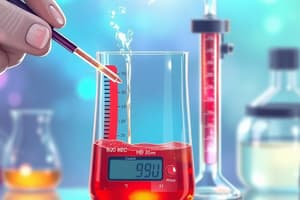Podcast
Questions and Answers
What is the composition of the positive electrode in a pH meter?
What is the composition of the positive electrode in a pH meter?
- Ag/AgCl
- Hg/HgCl (correct)
- Cu/CuCl
- Pt/PtCl
What solution fills the negative electrode of the pH meter?
What solution fills the negative electrode of the pH meter?
- 0.01N NaOH solution
- 0.1N HCl solution (correct)
- Saturated KCl solution
- Distilled water
What is the function of the potential difference in a pH meter?
What is the function of the potential difference in a pH meter?
- To indicate the temperature of the electrodes
- To convert pH readings into electrical signals
- To determine the concentration of H+ ions in the solution (correct)
- To measure the temperature of the solution
Which electrode in a pH meter is considered the reference electrode?
Which electrode in a pH meter is considered the reference electrode?
How does the H+ ion concentration affect the pH meter's readings?
How does the H+ ion concentration affect the pH meter's readings?
Flashcards
pH Meter Electrode Types
pH Meter Electrode Types
A pH meter uses two electrodes: a positive (reference) and a negative (glass).
Calomel Electrode
Calomel Electrode
The positive electrode, made of Hg/HgCl, and filled with a saturated KCl solution.
Glass Electrode
Glass Electrode
The negative electrode, made of Ag/AgCl and filled with 0.1N HCl solution.
Potential Difference in pH Meter
Potential Difference in pH Meter
Signup and view all the flashcards
Constant Electrode H+ Concentration
Constant Electrode H+ Concentration
Signup and view all the flashcards




